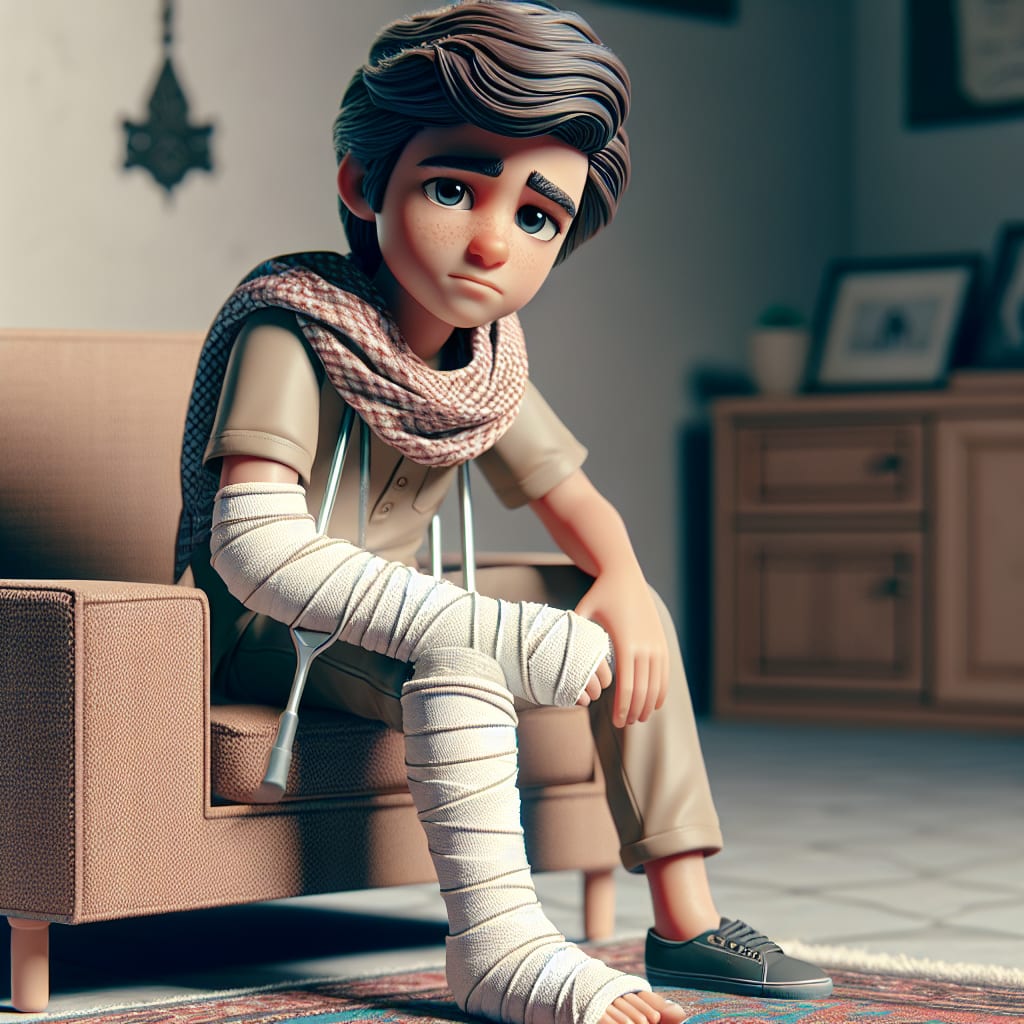Injuries, whether minor or major, can disrupt our everyday rhythm. It's crucial, therefore, to understand the distinctions between these two classifications and how they impact our health and recovery.
In this post, we will explore the differences in treatments, the seriousness of the injury, and more to guide you through these painful experiences.

What Is an Injury?
Before delving into specific types and impacts of injuries, it's important to establish a fundamental understanding of what an injury is.
An injury is defined as any form of damage to the body caused by an external force.
This force could arrive from a wide range of sources, be it an accident, a fall, a sharp object, or excessive physical exertion.
The severity of injuries can vary widely, as can their impacts, and they can be broadly classified into minor and major, as well as acute and chronic, as we have explored above.
Injuries happen when a body part is broken, a bone is crushed or fractured, or organs are harmed due to either physical trauma or exposure to harmful substances.
Different Type of Injuries: Acute and Chronic
Now, let's explore injuries more thoroughly by looking at two main types: acute and chronic.
The classification between acute and chronic injuries is based on the onset and duration of the injury.
Understanding the differences between acute and chronic injuries is crucial for determining the appropriate treatment protocol.
By seeking appropriate medical assistance promptly and adhering to all prescribed treatment instructions, you can significantly reduce the recovery period and potential complications.
Acute Injuries
Acute injuries are sudden and sharp, occurring as a result of a single, traumatic event. The most frequent causes of such injuries include falls, collisions, or awkward movements.
Acute injuries often present themselves with immediate symptoms such as severe pain, swelling, and inability to bear weight or move the affected part of the body.
Examples of acute injuries include:
- Sprained ankles
- Fractured hands
- Strained muscles
- Knee injuries, and more
Although acute injuries often present themselves suddenly and painfully, their healing process tends to be shorter. With proper treatment, most individuals can expect recovery within a few weeks or months.
Chronic Injuries
Chronic injuries, also known as overuse injuries, happen over an extended period.
They typically result from repetitive stress on a body part without allowing sufficient time for recovery. Symptoms often start as a minor discomfort that progressively worsens over time and can persist for several months or even years.
Chronic injuries often affect athletes, runners, or workers performing repetitive tasks.
Examples of chronic injuries include:
- Tennis elbow - Tennis elbow is a condition that causes pain around the outside of the elbow.
- Runner's knee - Runner's knee means that you have dull pain around the front of the knee (patella).
- Stress fractures - Stress fractures are tiny cracks in a bone. They're caused by repetitive force, often from overuse — such as repeatedly jumping up and down or running long distances.
- Carpal tunnel syndrome - Carpal tunnel syndrome (CTS) is pressure on a nerve in your wrist. It causes tingling, numbness and pain in your hand and fingers.
Differences Between Minor and Major Injuries
Injuries can be categorized into two distinct classifications: minor injury and major injury.
Understanding the differences between these two injury types is essential for determining the proper treatment, potential life-threatening implications, and long-term impacts.
What Are Minor Injuries?
Minor injuries typically do not threaten a person's life and have a limited impact on daily living.
They may cause discomfort and inconvenience but do not usually result in long-term damage if treated appropriately.

Common Examples of Minor Injuries
These minor or less severe injuries often require minimal medical intervention and can be treated at home or by visiting a clinic, or urgent care center.
Below are some examples of common minor injuries:
-
Cuts and Scrapes: These are skin injuries that cause breaking or scraping off of the outer layer of the skin. They can happen due to a variety of factors, such as accidents, falls, sharp edges, and more. These usually heal naturally but require cleaning and sterilizing to avoid microbial infections.
-
Bruises: These occur due to a fall or a hit, causing blood vessels beneath your skin to rupture and creating dark, discolored areas on your skin. Apart from some tenderness and discoloration, bruises generally heal without intervention within two weeks.
-
Sprains: These are injuries to ligaments, the tissues connecting bones to other bones. Sprains, often occurring in ankles or wrists, can cause swelling, pain, bruising, and mobility reduction. Management typically involves rest, ice, compression, and elevation (RICE).
-
Strains: These are muscle or tendon injuries often resulting from overstretching or overexertion. Strains can lead to pain, limited movement, muscle spasms, or slight swelling. Similar to sprains, strains can be managed using the RICE protocol and gentle stretching.
-
Minor Burns: These are categorized as first-degree burns affecting the top layer of the skin. Symptoms often include redness and slight pain. To treat minor burns, first, cool the burn site. Then, apply a product containing aloe vera with lidocaine for pain relief and cover it with a sterile bandage. For first-degree burns, you can also use aloe vera, honey, lotion, or antibiotic ointments to reduce dryness and speed up skin repair. Avoid applying oils, such as butter, as they can hinder the healing process.
-
Insect Bites or Stings: These minor injuries can cause various reactions, from mild swelling and redness to more severe allergic reactions. First aid measures usually involve removing the stinger (if present), cleaning with soap and water, and applying an antiseptic or hydrocortisone cream to minimize itching and swelling.
While these injuries are categorized as minor, it's essential to manage them appropriately and seek medical attention if they worsen or show signs of infection.
Each individual may react differently to injury, and what may start as a minor issue can escalate if not properly cared for.
Treatments for Minor Injuries
- Rest: Giving your body time to heal and recover is essential for a full recovery. Avoid physically demanding activities and get sufficient sleep.
- Clean wounds: Clean cuts and scrapes with soap and water to prevent infection.
- Ice: Apply cold packs to reduce swelling and alleviate pain.
- Compression: A mild compression can help control swelling and provide support in case of sprains and strains.
- Elevation: Keep the injured area elevated, as this helps minimize swelling.
- Over-the-counter medication: Use over-the-counter anti-inflammatory medication to manage pain and swelling, as needed.
What are Major Injuries?
Major injuries can be life-threatening and often result in significant impacts on daily life.
They can include fractures, dislocations, head trauma, serious burns, internal injuries, or severe cuts. Immediate medical attention is critical for these types of injuries and may involve hospitalization.
Common Examples of Major Injuries
Major injuries tend to be more severe in nature due to their potential for long-term consequences and immediate life-threatening risks. They demand immediate medical attention and often require a more extensive recovery period.
Here are a few common examples of major injuries:
-
Fractures: These are injuries where a bone is broken or cracked. They can range from small hairline fractures to compound fractures where the bone punctures the skin. Symptoms include severe pain, swelling, bruising, and inability to move the affected area. Fractures may require immobilization, potential surgery, and lengthy rehabilitation.
-
Concussions: A concussion, a type of traumatic brain injury, is caused by a blow to the head or violent shaking. Symptoms include confusion, headache, dizziness, nausea, and potential loss of consciousness. While most concussions are not life-threatening, they can have long-term impacts on brain function and require immediate medical evaluation.
-
Severe burns: Beyond first-degree burns are the more severe second and third-degree burns. These burns affect deeper layers of the skin and underlying tissues. They can result in extensive scarring, potential infections, long-term sensitivity, and require immediate medical attention and potential skin grafts.
-
Spinal Cord Injuries: Caused by damage to the spinal cord, spinal cord injuries can lead to loss of mobility or sensation. Depending on where the spine is affected, this can result in partial or complete paralysis. These injuries require immediate medical attention, intensive care, and long-term physical rehabilitation. According to MOH, the number of mobility loss in older residents grew from 25,500 to 50,000 between 2000 and 2020.
-
Internal injuries: These involve damage to internal organs or internal bleeding, often caused by trauma. Symptoms can be delayed and include pain, dizziness, fainting, and a swollen or bruised area. These are medical emergencies requiring immediate care as they can lead to severe complications or death if untreated.
-
Severe head injuries: These can involve skull fractures, brain damage, bleeding, and bruising in the brain (such as a contusion or hematoma). Symptoms can include loss of consciousness, severe headaches, confusion, seizures, and neurologic deficits. They are medical emergencies and can cause permanent damage or be life-threatening.
These major injuries examples illustrate situations where immediate professional medical attention is crucial to provide appropriate treatment and prevent further complications.
Depending on the severity, rehabilitation can take weeks to even years, and in some cases, the damage may be permanent. It emphasizes the need for safety and preventive measures to avoid such injuries.
Treatments and Considerations for Major Injuries
-
Emergency treatment: Call 995 for emergency medical assistance or go to the nearest emergency room as quickly as possible. Time is crucial in preventing irreversible damage or life-threatening complications.
-
Surgical intervention: Major injuries often require surgery to repair damaged tissues, bones, or organs.
-
Rehabilitation: Physical therapy, occupational therapy, or other specialized rehab programs may be necessary to regain strength, mobility, and independence.
-
Psychological support: The emotional impact of major injuries can be overwhelming. Seek support from professionals and loved ones to navigate the recovery process.
What to Do When You Are Injuried?
By familiarizing yourself with the differences between minor and major injuries, you can better understand their potential impacts and how to manage them effectively.
-
Assess the situation: First, evaluate the severity of the injury and determine if it's minor or major.
-
Call for help: In case of major injuries, always call 995 or your local emergency number.
-
First aid: Start administering first aid if you are trained to do so. For minor injuries, clean, and treat the wound accordingly.
-
Seek medical attention: No matter the injury severity, follow up with a healthcare professional for further evaluation and treatment.
What Should You Know about Workplace Safety and Health (WSF) Act in Singapore?
The Workplace Safety and Health (WSH) Act is an essential part of a framework to cultivate good safety habits in all individuals, so as to create a strong safety culture in workplaces.
The Workplace Safety and Health Act covers the safety, health and welfare of persons at work in a workplace.
According to Workplace Safety and Health (WSH) Act by Ministry Of Manpower (MOM), major injuries are non-fatal but severe injuries.
They are defined by:
- Nature of injury
- Part of the body injured
- Incident type
- Duration of medical leave
Examples of major injuries include:
- Amputation
- Blindness
- Deafness
- Paralysis
- Crushing, fractures and dislocations: head, back, chest and abdomen, neck, hip and pelvis
- Exposure to electric current
- Asphyxia or drowning
- Burns with more than 20 days medical leave
- Concussion with more than 20 days medical leave
- Mosquito borne diseases with more than 20 days of medical leave
- Virus outbreak with more than 20 days of medical leave
What is #GPFirst Programme?
The GPFirst programme, in Singapore, encourages people with mild to moderate medical conditions to visit their nearest General Practitioner (GP) in your area before heading down to the Emergency department.
Heading to your GP first frees up resources for more serious medical emergencies or major injuries.
If your GP refers you to the Emergency Department, you'll get:
- Priority over non-emergency cases
- $50 subsidy on prevailing attendance fee
This programme includes the following Emergency Department (ED) or Urgent Care Centers (UCC):
- Changi General Hospital (CGH)
- Khoo Teck Puat Hospital (KTPH)
- National University Hospital (NUH) – Adult ED only
- Ng Teng Fong General Hospital (NTFGH)
- Sengkang General Hospital (SKH)
- Singapore General Hospital (SGH)
- Tan Tock Seng Hospital (TTSH)
- Alexandra Urgent Care Centre (AH UCC)
- Urgent Care Centre (UCC) @ Admiralty
Click here to search for a participating clinic near you. Please select "GPFirst" under Programme.
Conclusion
Understanding the nature of both minor and major injuries, their implications, and treatment methods is crucial as it allows us to be better prepared to manage unforeseen incidents.
We encourage you to not ignore any injury, be it minor or major, and seek advice from healthcare professionals.
Remember, knowledge is power and sharing is caring! Let us know how this article helped you, and don't forget to share this information to help others also.



